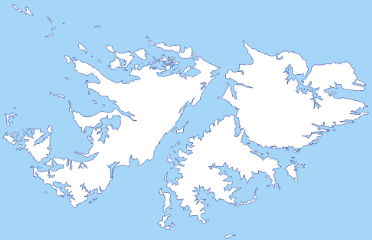
Cartography and Currency - I
The Falklands/Malvinas Islands Dispute
Introduction
THE DRAWING AND MAKING of maps—cartography—is a way of communicating spatial information and linking that information to other aspects of reality. Cartography is also an intrinsically political enterprise. Maps are potent examples of what the historian Michael Billig once called “banal nationalism”: everyday expressions of national identity that reinforce the sense of national belonging through their sheer ubiquity and use. By showing people where they are, maps tell them who they are. Maps and map-making also serve to construct the territoriality of the modern nation-state itself, enabling a conception of political authority that is exercised within precisely definable borders and across homogenous spaces. They tell what, or who, is inside or outside of those borders. In that sense, maps are basic instruments of political control.
National monies play an analogous role in bolstering the modern state’s capacity and authority to manage the economy that operates within those territorial borders. And, as with maps, currencies and the iconography they employ also serve to amplify nationalist sentiments. As long as national borders and national identities in their many aspects remain contested, controversies over them will inflame disputes about what does, or doesn’t, appear on a country’s paper money.
In 1982, Great Britain and Argentina fought a brief conflict over who controls an island archipelago In the South Atlantic Ocean which the British call the Falklands and the Argentines the Malvinas. While the Falklands War resulted in a decisive British victory and Britain’s continued control over the islands, the conflict also played out on banknotes issued by both sides, which involved the appearance of maps as devices on those banknotes to underscore the legitimacy of their territorial claims.
Numismatic Aspects of the Falklands War
While it has been long debated whether empire ever made economic sense to Great Britain, there is little ambiguity about the minute significance of the Falkland Islands (Malvinas) for post-imperial Britain of the late 20th century. The brief Falklands War of 1982 occurred over territory that British governments had openly expressed an interest in relinquishing, and to whose inhabitants (almost all of British origin) Great Britain had even denied citizenship. Under its control since 1833 and a Crown colony after 1841, by the 1970s British governments seemed to have acquiesced in the Falklands’ eventual transfer to Argentina, which had regularly asserted its claims of sovereignty, via a leaseback arrangement similar to that existing for Hong Kong. The big sticking point had been the inconvenient fact that the small population of Falklanders (who had their lobby in Parliament) had no interest in becoming Argentine subjects. The vastly larger population of sheep expressed no opinion.
With Argentina’s 1982 invasion launched by the military junta led by General Leopoldo Galtieri, Britain’s slow drift toward imperial disengagement abruptly snapped into reverse. Beset with economic crises at home, Argentina’s government thought a quick and successful takeover would rally the country to its side. This calculation proved disastrously wrong, but only because of the junta’s assumption that, when presented with the fait accompli of occupation, the British would acquiesce. As with Iraq’s ill-starred invasion of Kuwait a decade later, a secondary but decisive cause of the Falklands conflict was the failure of the British to signal sufficient resolve that they would defend their colonial outpost in the event of an actual invasion.
Thus, the Falklands War, when it broke out, was fueled entirely by the claims and conceits of sovereignty. The conflict was, as the Argentinian writer Jorge Luis Borges memorably put it, “two bald men fighting over a comb.” The ten-week conflict that ensued resulted in the expulsion of Argentina’s invasion force and the deaths of some 900 soldiers on both sides, most notably through the sinking by torpedo of the Argentine cruiser General Belgrano. The war’s outcome also reverberated through both countries’ domestic politics, leading to the toppling of Galtieri’s government and Margaret Thatcher’s triumphal re-election in 1983.
Numismatically, the conflict has had repercussions for both sides. Argentina, which has a complicated and chaotic monetary history, was using the peso at the time the war broke out and by 1985 would embark on a brief adventure with a new currency unit, the austral. Like other British Overseas Territories such as Gibraltar or St. Helena, the Falklands had its own limited-use version of the British pound. Although the monetary needs of such a small economy were minimal and the problem of counterfeiting nonexistent, the pre-invasion version of the Falkland Islands pound then in circulation was striking for how retrograde and even primitive it looked, even in comparison with currencies of the other Overseas Territories. For sixty years between 1921 and the outbreak of the war the Falklands had to make do with the same stodgy banknote style, printed by Thomas De La Rue: on the front, a medallion profile of the monarch, facing either left or right depending on monarchical succession; on the back, nothing but a pattern of guilloches, making the currency notes effectively uniface.

The front and back of a Falkland Islands one-pound note from 1982. Although its circulation needs were limited, for the previous sixty years Falkland Islands currency looked exactly the same, except for changes in the monarch. (Image source: Heritage Auctions).
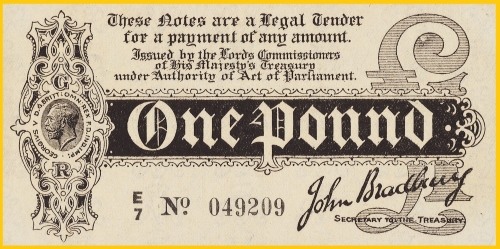
A uniface one-pound Treasury Note (the so-called "Bradbury Note") from 1914 (Image source: Heritage Auctions).
Other than official verbiage recognizing the note as legal tender by the Government of the Falkland Islands, nothing on the banknotes –no device, vignette, or other design element—was redolent in the least of the Falkland Islands and its built or natural environments. Even the profile of Elizabeth on those issues dated 1967 to 1982 remained frozen in its youthful version, unlike updated variants used elsewhere in the world. Overall, the Falklands’ currency appeared hardly more sophisticated than the emergency issues of the British Treasury’s “Bradbury” notes during World War I. In their symbolic effect, the Falkland pound notes signaled a palpable official indifference to the existence of the Falkland Islands as a British possession.
In stark contrast, pound notes issued during those same years (late 1970s – early 1980s) for Gibraltar and St. Helena, were colorful, lively, and clearly reflective of the territories in which they circulated. Pointedly, the banknotes of both these Overseas Territories included depictions of the physical islands of Gibraltar and St. Helena. In the case of Gibraltar, its more ambitious currency might well have simply reflected its larger population (some ten times that of The Falklands) and the self-evident geostrategic importance to Great Britain of its location at the entrance to the Mediterranean Sea. Otherwise, the Falklands and St. Helena were (and are) similar in their population size, isolation, and relative lack of economic diversity.
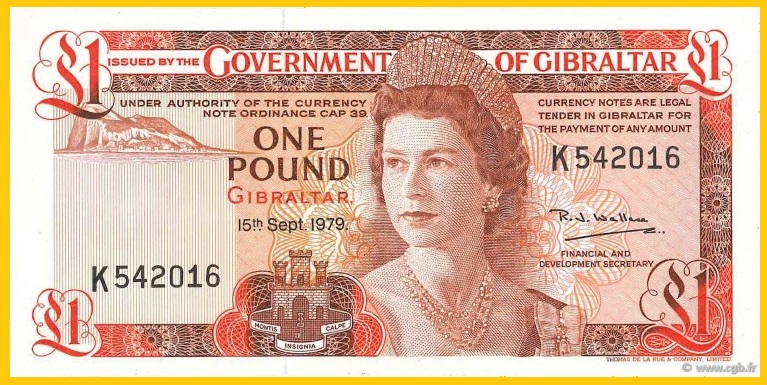
Above: the front of a Gibraltar one-pound note from 1979, with the Queen to the right and a panoramic view of Gibraltar to the left. The note's reverse (not shown) depicts the Convent of Gibraltar. Below: the front of a St. Helena one-pound note from the late 1970s. A panoramic view of St. Helena harbor, in the style of Jan Van Ryne, appears to the left of the Queen's portrait. Interestingly, the reverse of the note (not shown) features the coat of arms of the East India Company (Image Sources: Numista / CGB Numismatique).
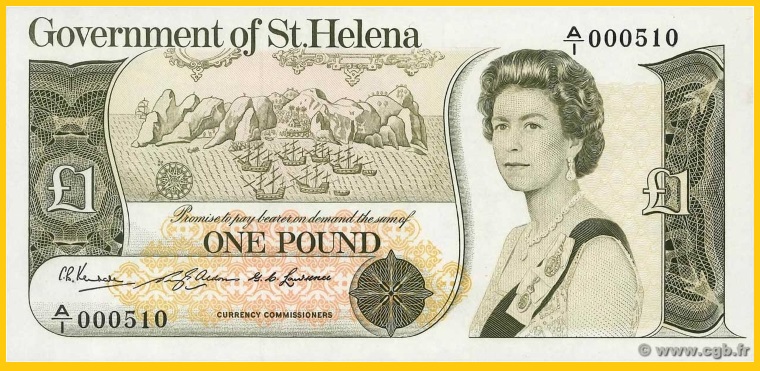
Wars, no matter how foolhardy, have a distinctive way of creating sunk costs that become retrospective justifications for their original causes. For the British, having spent significant blood and treasure on defending their desolate outpost, they had no choice but to end their monetary neglect of the Falklands. In 1983 Great Britain hastened to issue coins and banknotes denominated in Falkland Islands pounds to mark the 150th anniversary of its control which, prior to the 1982 conflict, it had shown an interest in negotiating away to Argentina. As the five-pound note pictured here shows, Falklands currency finally acquired the complexity and vibrancy appropriate for a typical, late-20th century national banknote. Instead of the lifeless cameo profile of the earlier banknote series, a larger midlife version of Queen Elizabeth now appeared, facing frontally, decked out in regal splendor with the Vladimir tiara and the Golden Jubilee necklace. To the left of her portrait is the Falkland Islands coat of arms, the latest version of which had been adopted in 1948. An obvious bit of sovereign symbolism, this heraldic device finally made it onto the currency. Even more important than the two vignettes of the local fauna is what appears as an underprint beneath the note’s text—a map of the Falklands Islands. On the reverse of the note, instead of an anonymous clump of guilloches, the British managed to find two Falklands building structures (the Governor’s House and Christchurch Cathedral) that were banknote-worthy.
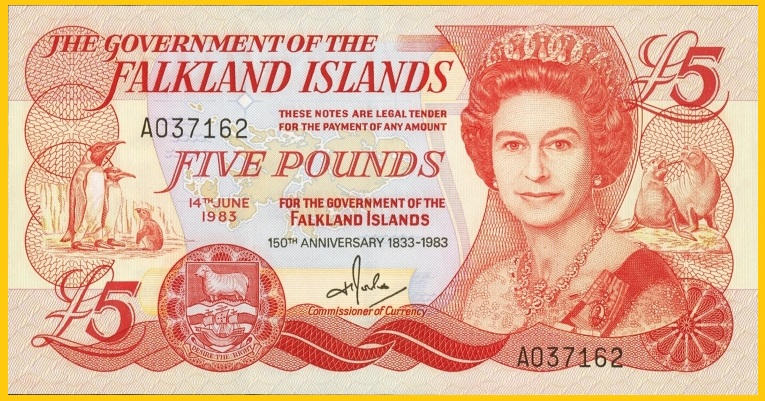
Above and Below: the front and back of a Falkland Islands commemorative five-pound note from 1983, marking the 150th anniversary of British control. To the left of the Queen's portrait is an underprint map of the Falklands; beneath that is the Falkland Island's coat of arms. The note's reverse features two structures in Stanley, the Government House and Christ Church Cathedral. Subsequent Falklands currency issues are identical to this (Image source: Numista).
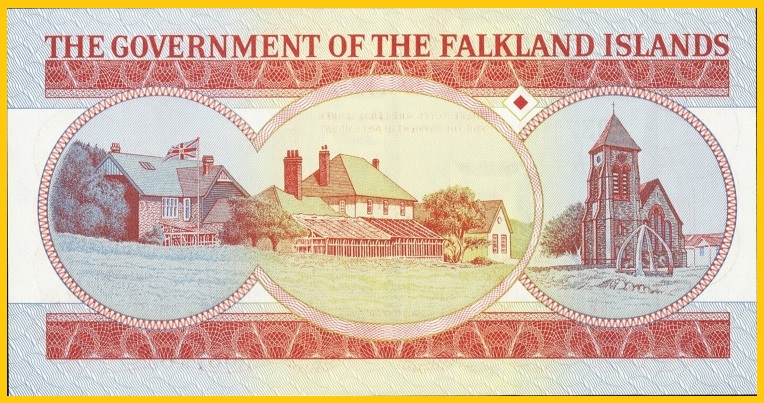
For its part, as the loser in the conflict Argentina had nothing to celebrate but an abundance of resentment to nourish. On the war’s 25th anniversary in 2007, Argentina issued a range of coins and a Malvinas-themed 50-peso banknote in 2015. Just about all of these coins and the banknote feature some rendition of the disputed island archipelago. In particular, the very precise cartographic display on the front of the note, shown here, amounts to a veritable Rorschach test of Argentinian nationalist grievances, presenting at it does a composite juxtaposition of all the island territories claimed by Argentina (and controlled by Great Britain) in the vast expanse of the South Atlantic Ocean. At the top of the note is language introducing these areas as the “Malvinas, South Georgia, and South Sandwich Islands and the Surrounding Maritime Spaces of the South Atlantic.” Just beneath that appears the text ningún suelo más querido de la patria en la extension (roughly: no soil more dear than an undivided homeland), a fragment from the lyrics to a patriotic song, “Marsha de las Malvinas,” composed by José Tieri and written by Carlos Obligado in 1940. This piece of music has since been designated the official anthem of Argentina’s Tierra del Fuego Province, under whose administration the disputed territories ostensibly belong.
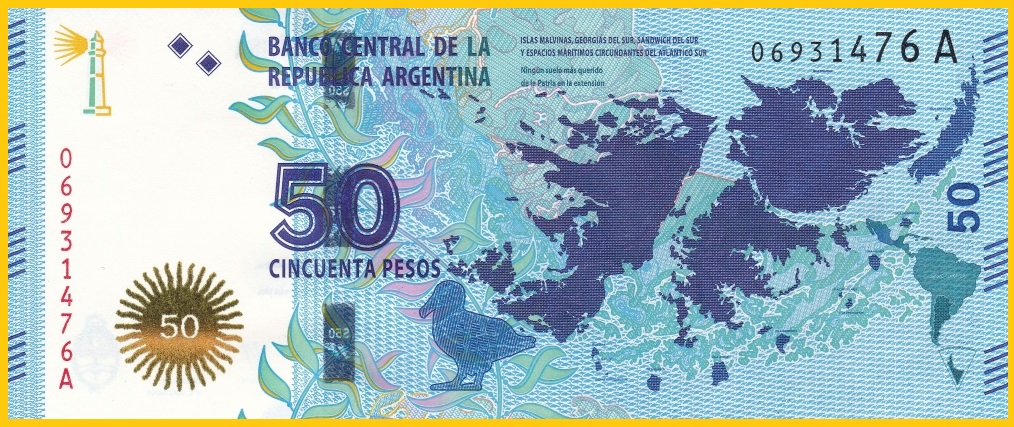
The front of the 50-peso note presents a complex cartographic composition. Atop an underprint of seaweed appears a very precise outline of the Malvinas archipelago. To the right, in an arc tracing diagonally from top to bottom, are the South Georgia and Sandwich Islands. Appearing as if they were geographically adjacent to Malvinas, these territories are actually hundreds of miles to the east. Finally, in the bottom right corner, an inset map of Latin America illustrates Argentina's claims in Antarctica (Image source: Numista).
In the center of the banknote’s front are the Malvinas (Falklands) themselves, comprised of the two basic land masses—Gran Malvina Island (West Falkland) and the barbell-shaped Soledad Island (East Falkland)—separated by the Strait of San Carlos (Falkland Sound). Just to the right of that appears, somewhat incongruously, South Georgia Island, which was also briefly occupied by the Argentinians during the 1982 conflict. Seemingly situated, in the note’s composition, just off the east coast of Soledad/East Falkland Island, South Georgia Island is actually some eight hundred miles to the east in the South Atlantic; likewise, such minute volcanic specks as Cook, Thule, and Bellingshausen Islands, carefully labeled as such on the note and depicted as adjacent to the Malvinas/Falklands, are actually parts of the South Sandwich Islands chain which is, in turn, hundreds of miles even further to the east and south of South Georgia Island. Finally, an inset map situates Argentina with the continent of South America and the entire Southern Hemisphere, including its claims in Antarctica, which overlap with both Great Britain’s and Chile’s and represent yet another territorial dispute with its own history.
Taken together, the cartographic mash-up on this note expresses Argentina’s territorial aspirations in the vast South Atlantic Ocean. These territories also correspond to two of the five departments that comprise Argentina’s Tierra del Fuego Province (formally, Provincia de Tierra del Fuego, Antártida e Islas del Atlántico Sur). Created in 1990, this Province represents an administrative placeholder for Argentina’s various claims. Only the first three of the Province’s departments, comprising Tierra del Fuego itself, are currently under Argentina’s control.
If Great Britain was hard put to find anything distinctive about the Falklands to place on its commemorative note, for Argentina the problem was more pronounced. The British commemorative notes of 1983 made use, on their reverses, of two substantial buildings with some official or historical significance. Since both structures reflect British rule over, and presence on, the islands, they obviously could not be employed on an Argentine banknote. Indeed, the most common animal on the islands—sheep—also could not have appeared on Argentina’s banknote (but could, and did, on Great Britain’s banknote), as they were intrinsically British in their significance for the islands’ colonial history. First imported by the British in the mid-19th century, sheep and sheep farming remain at the heart of the islands’ limited economy. A sheep also appears on the coat-of-arms that flies on the Falkland’s flag itself.
The reverse of the 50-peso note struggles with the same problem of what symbols and themes the Argentines could appropriate and place on a Malvinas-themed banknote. No Argentines in any significant numbers have ever lived on the islands. As a result, there is no plausible claim to be made that a subject population, whose Spanish language has been suppressed or whose culture has been erased, cries out for liberation from its colonial overlords. Nor is there a meaningful diaspora of Malvinas exiles or their descendants who can maintain such grievances. The figure on horseback pictured on this side of the note to personify Argentina’s sovereignty claims is Antonio Rivero, a gaucho who led a deadly attack in 1833 upon several officials of the company that had hired him to work on the islands.
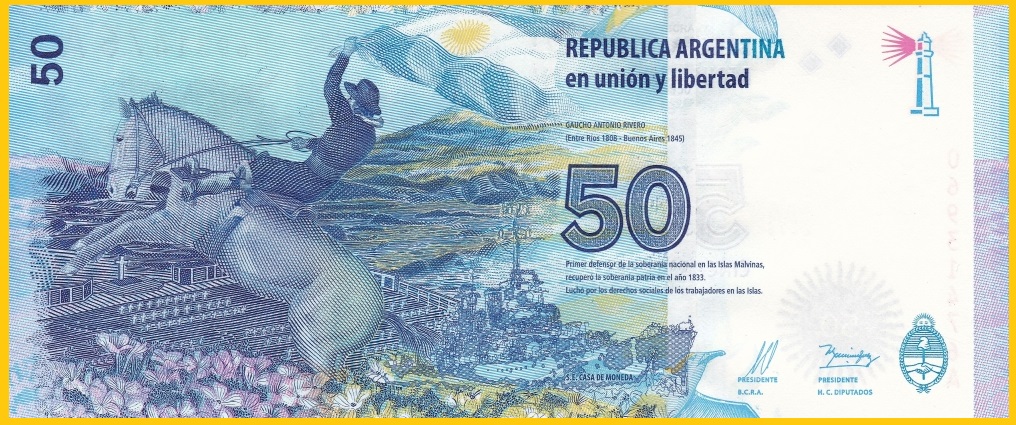
Above: The back of the 50-peso note celebrates the gaucho Antonio Rivero, in the foreground astride a rearing horse and waving an Argentine flag. Rivero led a brief revolt of workers in 1833 against the leaders of a commercial operation on the Malvinas. In the background, left, appears the Argentine Military Cemetery, established by the British on East Falkland when Argentina refused to accept the return of its soldiers' remains. To the right emerges the ARA General Belgrano, the cruiser sunk by a British torpedo. Below: pictures of the Argentina Military Cemetery and the General Belgrano (Image Sources: Numista; Falklands Tourism Board; Reuters).

Despite being celebrated on the note as an upholder of Argentine sovereignty, Rivero’s dispute was more about wages owed to workers who were employed at the time by an agent of Argentina, the Hamburg-born merchant Luis Vernet. Vernet had endeavored to establish a commercial operation on the islands in the 1820s; after 1828, Vernet embarked on a colonization scheme with the approval of Buenos Aires, which bestowed upon Vernet an official title but little in the way of resources. As with Rivero, it would be a stretch to regard Vernet as some folk hero of Argentine sovereignty, as he was equally ready to work with the Argentines or the British when it served his business interests.
Luis Vernet’s role in the numismatic history of the Falklands/Malvinas islands also fits awkwardly into Argentina’s sovereignty narrative. As a pamphlet published by Argentina’s central bank points out, Vernet’s company was the first entity to issue currency specifically for the Malvinas, a company scrip to be used for purchases on the islands, but which promised the bearer redemption in pesos in Buenos Aires. These Malvinas notes appeared nearly seventy years before the British introduced their own local circulation. However, as salient a monetary precedent for Argentina as this might seem, it was not an auspicious one, as it was the unwillingness of Vernet’s officials to accept his scrip when presented by the gauchos which precipitated their revolt. The Malvina’s first, Argentine, currency was a characteristically bad one.
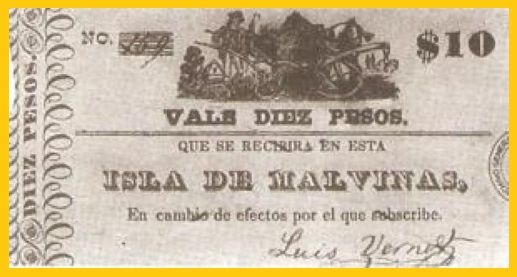
A ten-peso scrip note issued, signed by Luis Vernet, used to pay workers at the first colony on the Malvinas. The unwillingness of Vernet's company officers to accept this scrip led to a worker revolt.
Whatever Rivero’s or Vernet’s historical significance, it remained the case, however, that it was an act by Great Britain that created the long conflict over the Falklands/Malvinas. It was the British who intervened in 1833 to expel an Argentine military outpost from Soledad Island, thereby reasserting British sovereignty claims that they had previously neglected for over a half a century (when disengaging in 1774, they did manage to leave behind a plaque declaring British dominion). In the 1820s, the young government in Buenos Aires had claimed authority over the Falklands according to the legal doctrine of uti possidetis –territorial claims made by the previous Spanish viceroyalty of La Plata should devolve upon the successor government. This was a genuine argument under international law, and probably a stronger one initially than what the British used to justify ejecting the Argentines. Yet the case for Argentine sovereignty always remained an abstract one, while British control over the next century and a half created facts on the ground that made Argentine objections increasingly impractical, not to mention unpersuasive to the people who actually lived on the islands.
As a consequence, one necessary part of modern Argentina’s case against British control over the Falklands is to question the authenticity of the islands’ residents as a “people.” As one pro-Malvinas analysis puts it:
The population of the Falkland/Malvinas Islands is mainly temporary, constantly renewed, and has a completely artificial demographic growth. Despite the efforts made to create a “national” identity on the islands, a population with these characteristics does not make up an ethnically and culturally distinct group to the administering power, a separate people subject of the right to self-determination.
In this view, Falklanders have no organic connection to the islands, and are but merely contingent settlers who numbers require periodic replenishment by Great Britain and who serve as a “political instrument” of colonial control.
What the Argentine argument against Falklanders’ self-determination recognizes is that, however they may be represented symbolically, genuine nations must have an embodied reality, i.e. they must be made of up live people. Yet, as the reverse of the Argentine banknote as much admits, the only permanent and meaningful presence of Argentine bodies on the islands are the dead soldiers buried in the Argentine Military Cemetery, casualties of the 1982 conflict. At the conclusion of those hostilities, Argentina declined the repatriation of the soldiers’ remains, arguing that, by the logic of Argentina’s sovereignty claims, their dead were already present on Argentine soil. A strange gesture of self-humiliation, Argentina’s refusal to take back its own soldiers’ bodies left it up to the British themselves to provide them with a proper burial under dignified circumstances. Argentines can pay their respects to the fallen only by traveling to the island as tourists. As a further, macabre touch, in the center foreground of the same side of the note emerges the wreck of the General Belgrano, seemingly encrusted from its time on the floor of the ocean, to once again sail and fly the Argentine flag.
While these comments about the banknote’s design elements appear critical, they merely reflect the symbolic dilemma such a commemorative banknote confronts. Since there is practically nothing about the built environment on the islands or the lived experience of its residents that is particularly Argentine, all that the note can do is memorialize the sacrifices of Argentina’s armed forces. If the front of the note uses a cartographic scheme to assert Argentina’s formal claims in the South Atlantic, the reverse seeks to make those claims emotionally resonant in the sense suggested by the words ningún suelo más querido de la patria en la extension. The only material available to do so, however, are the residues of Argentina’s defeat in 1982. In this sense, the war’s sacrifices provide their own self-validating rationale.
Conclusion: Currency in a Frozen Conflict
Although Great Britain and Argentina reestablished diplomatic relations in 1989, the Falklands/Malvinas dispute remains a frozen conflict after more than forty years. Argentina repeatedly asserts its sovereignty claims, as it must to keep them valid. For good measure, Argentina’s 1994 constitution pre-commits any future government to continue seeking the restoration of Argentine control over the islands. For the British, winning the Falklands War not only cost it billions of pounds at the time, but locked it into an unending financial commitment to maintain a deterrent garrison on the archipelago. Whether it wants it or not, Great Britain is committed to the indefinite deployment of scarce military resources in the South Atlantic.
The attitudes and logic of each side’s position on the Falklands/Malvinas dispute have been reflected on both countries’ currency issues. Prior to the 1982 conflict, Great Britain’s tepid interest in the Falklands was evident in its neglect of their dependency’s supply of paper money, as minimal as its circulation requirements were in any case. Save for changes dictated by monarchical succession, the appearance of Falklands pound notes remained unaltered for over sixty years, even as the banknotes of other British Overseas Territories like Gibraltar and St. Helena underwent upgrades. Having just fought to reassert its control over the Falklands, Great Britain had no choice but to reaffirm its sovereign commitment by updating the iconography of its currency in 1983, which conveniently coincided with the 150th anniversary of Britain’s ejection of the Argentine garrison from East Falkland (Soledad).
As expressions of nationalist aspirations and national identity, modern states resort to any number of symbols and other devices to make their currencies distinctive. These can include famous political or cultural personages; architecturally-distinctive monuments; or other prominent geographic features. Since the Falklands are a desolate landscape with a tiny population and limited economic potential, there are few aspects of life there that lend themselves to visual representation on a banknote. Of course, the British monarch is a perennial personification of British sovereignty whose visage can be slapped upon most any document. However, the monarchy can only serve as the symbolic genus of sovereignty; its differentia must be some design element specific to the space over which British sovereignty is being asserted. Given the paucity of themes available from life on the Falklands, the 1983 commemorative pound notes fall back on the heraldic device of its coat of arms (invented 1948) which itself is a rather minimal composition, consisting of but a sheep (the fauna), a patch of grass (the flora), and … the ship which first sighted the islands.
The other notable feature on the 1983 notes was placement of a map of the Falklands into the background design. As with the Gibraltar and St. Helena pound notes shown here, a representation of the physical geography of the sovereign space being governed substitutes for the limited number of other symbolic possibilities. A sharper way of making this point is that countries may resort to placing cartographic elements on their banknotes precisely when their claims to territorial control are otherwise uncertain or even contested. Two prominent examples that illustrate this possibility are the banknotes of Russia (which, among other elements, flaunt the recent acquisition of Crimea) and those of the Eurozone itself. Not only is the European Union not a completely sovereign entity, but its common currency does not even circulate within all its member countries' borders. Notorious for their avoidance of any national symbols, euro banknotes resort to the absurdity of fictional bridges and entryways to illustrate the EU's bloodless ideal of supranational unity. By contrast, the placement of a map of Europe on all euro banknotes is the only design element that corresponds to any reality, and that is the sheer physical existence of the European continent itself.
For Argentina, the challenge of a banknote iconography supporting its Malvinas claims is complicated by the historical fact that Argentines have not played any role in life on the islands for nearly two hundred years, save for militarily occupying it for a couple months in 1982. In a more complex and decidedly poignant way, Argentina’s 50 peso note of 2015 also asserts its sovereignty claims through the device of a map that brings together all of Argentina’s territorial aspirations strewn across the South Atlantic into a single, and geographically surreal, cartographic portmanteau. Elements on the note’s reverse highlight the symbolic difficulty of claiming the Malvinas as Argentine soil. The only Argentine bodies on las Islas Malvinas are dead ones. However, by the terms of Argentina’s sovereignty claims, these dead bodies must count for more, in terms of national authenticity, than the live bodies of Great Britain’s artificial settler garrison.
....
REFERENCES
Banco Central de la República Argentina. Numismática de las Islas Malvinas Argentinas (Buenos Aires, 2008), esp. pp. 13-15.
Billig, Michael, Banal Nationalism (London: Sage, 1995).
Branch, Joseph, “Mapping the Sovereign State: Technology, Authority, and Systemic Change” International Organization 65 (Winter 2011), pp. 1-36
Hastings, Max and Simon Jenkins, The Battle for the Falklands (New York: Norton, 1982), esp. ch. 2.
Kemp, Brian “Note Issues of the Falkland Islands” I.B.N.S. Journal 14, no. 2 (1975), pp. 106-7.
Kohen, Marcelo G. and Facundo D. Rodriguez, The Malvinas/Falklands Between History and Law (CreateSpace Independent Publishing, 2017), quote p. 208.
Penrose, Jan, “Designing the Nation. Banknotes, Banal Nationalism and Alternative Conceptions of the State” Political Geography 30, No. 8 (Nov. 2011), pp. 429-440.
Pointon, Marcia, “Banknotes and Nationalism” in Imagining Nations, Geoffrey Cubitt, ed. (Manchester University Press, 2018), pp. 219-254.
Ware, Richard, “The Case of Antonio Rivero and Sovereignty Over the Falkland Islands” The Historical Journal 27, No. 4 (December 1984), pp. 961-967).


